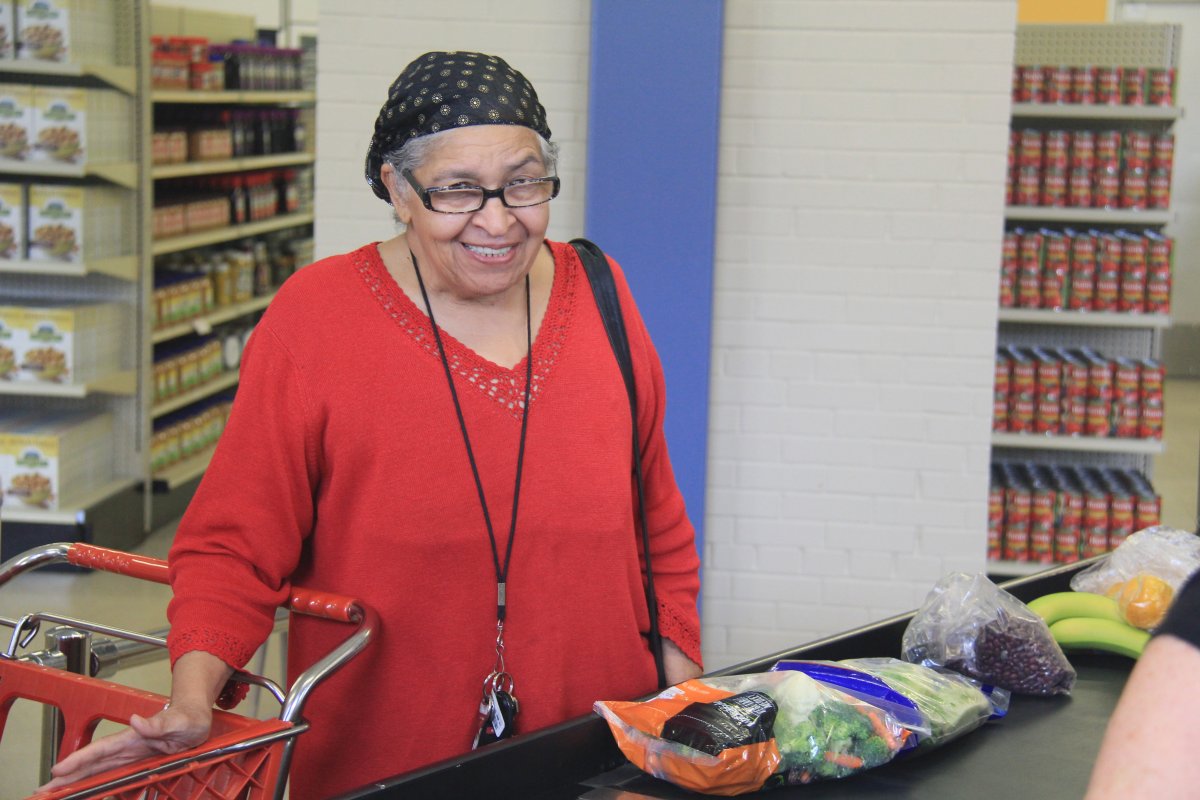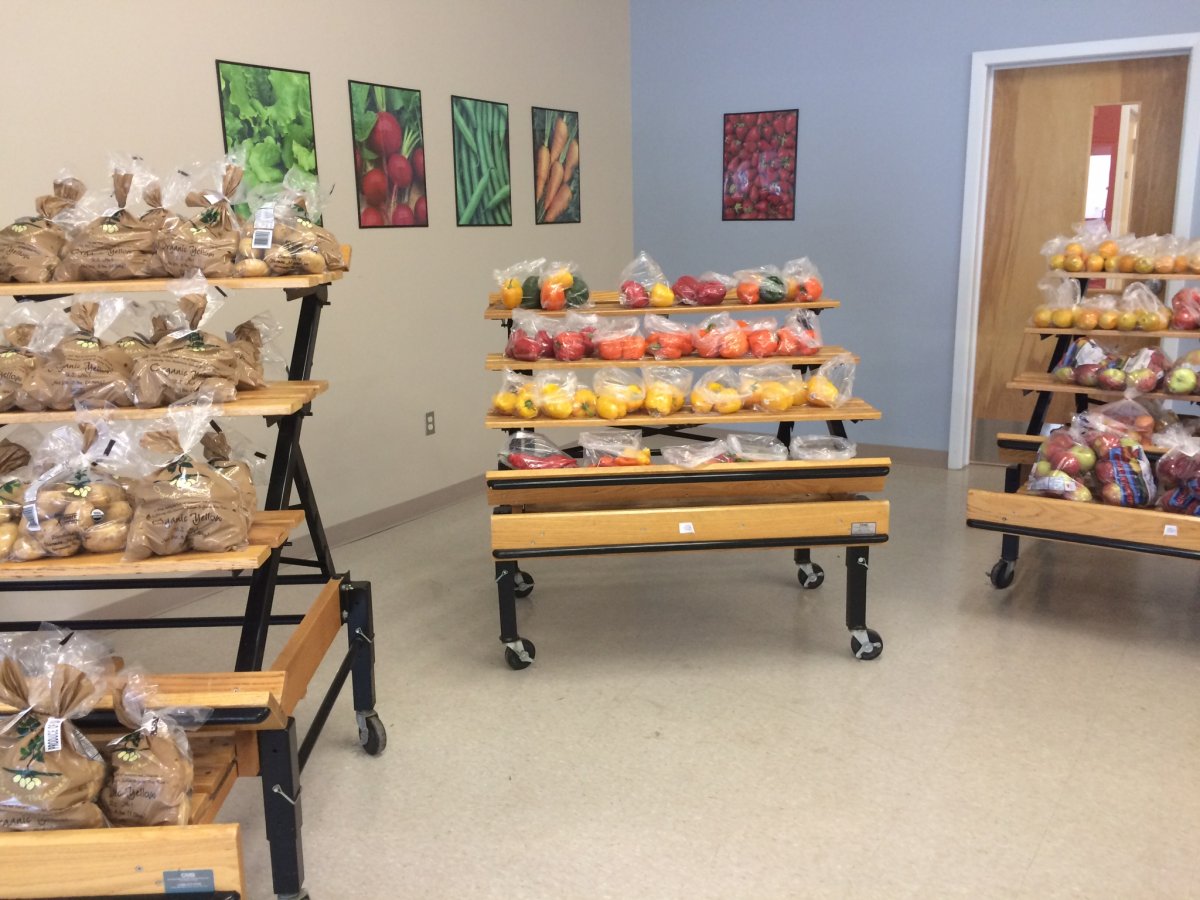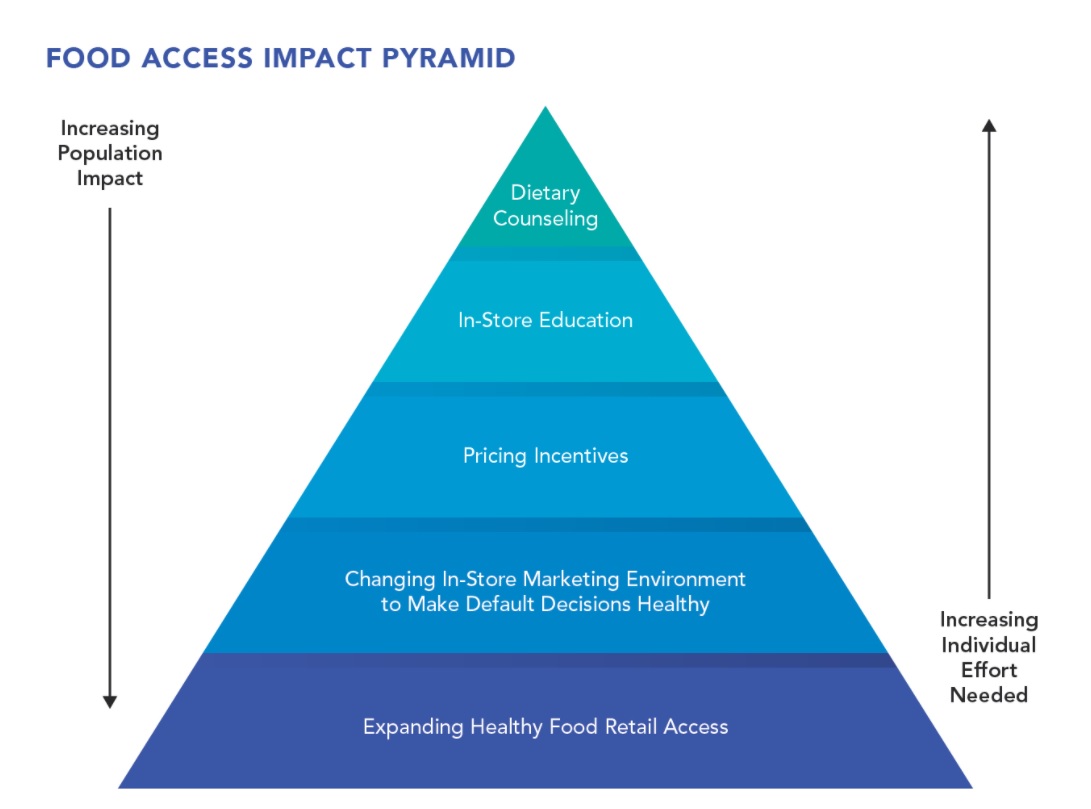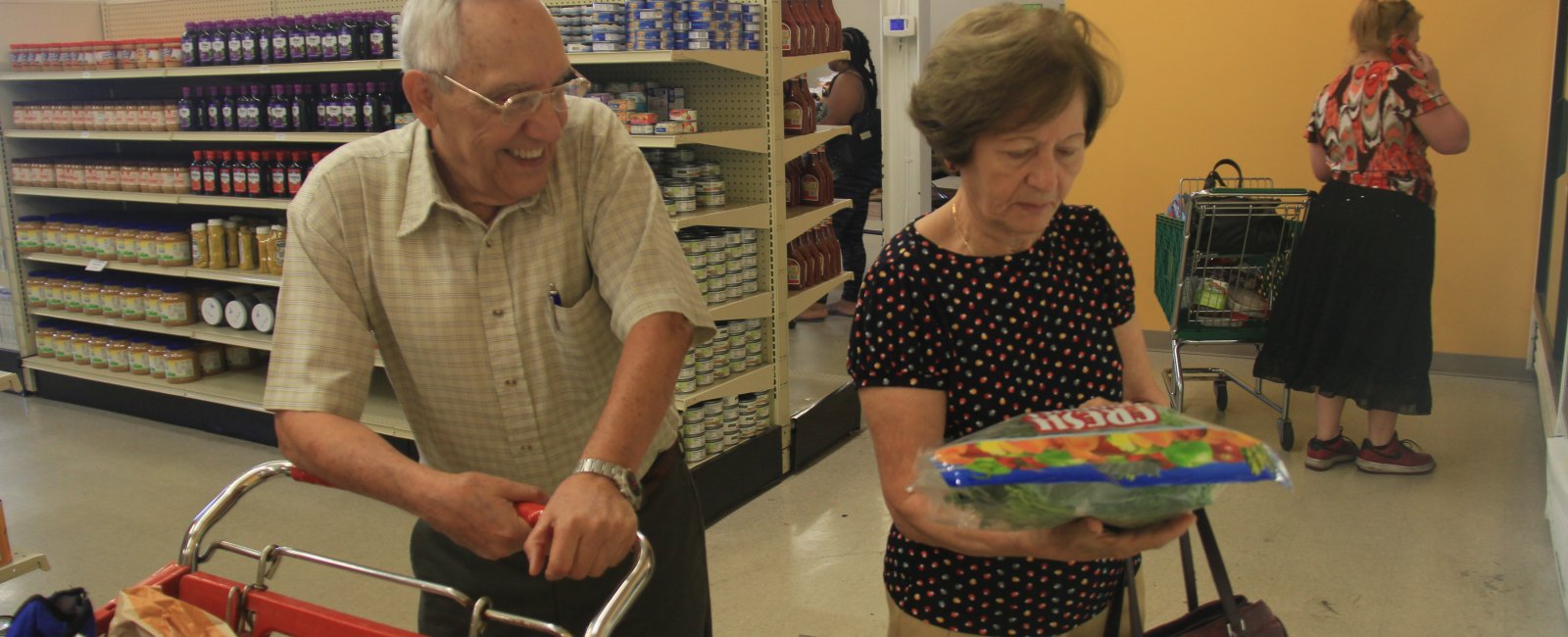Program: Healthy corner stores
Takeaways
Healthy corner store initiatives employ a suite of strategies to increase access to and promote healthy food options in small retail settings. These initiatives align with recommended strategies to promote greater consumption of fruits, vegetables, and other healthy foods. Hospitals can partner with public health departments and local agencies to enhance these efforts by providing funding, training, and resources to help store owners stock and promote healthy food choices.
- Corner stores may be the primary retail food establishments and the only convenient outlets that accept federal Supplemental Nutrition Assistance Program (SNAP) benefits in some neighborhoods.
- The majority of corner stores are independently owned and, due to their small size, face barriers to stocking healthy items.
- Convenient access to healthy food has been found to positively influence healthy eating behaviors.
Across the United States, not all people have access to healthy food. Low-income, minority, and rural communities disproportionately face this issue and experience higher rates of obesity and diet-related disease.
Healthy corner store initiatives aim to address these disparities by increasing the availability of healthy food items in small stores, an increasingly important retail food source in many communities. These efforts involve collaboration between local government, business owners, and community-based organizations, including health care institutions.
The changes resulting from healthy corner store initiatives can have wide-reaching community benefit. Improving healthy food access can be a valuable component of strategies to prevent obesity and diet-related health conditions. In supporting corner store initiatives, hospitals can help shape the community food environment by changing what food is available and promoted to consumers and bolster new business models that foster community health.
Community food environments and food options
A community’s retail food environment shapes its residents’ food options and ultimately their choices. Access, availability, and affordability of healthy options influence health outcomes. Across the United States, there are significant disparities in access to stores that sell healthy foods, along racial/ethnic, socioeconomic, and geographic lines. Numerous studies have found that residents of low-income, minority, and rural communities regularly encounter barriers to accessing nutritious foods. Limited access contributes to the high rates of obesity, diabetes, and diet-related diseases that plague these communities.

Food deserts and swamps
Both “food deserts” and “food swamps” are more prevalent in under-resourced communities compared to wealthier neighborhoods. While food deserts are areas with inadequate access to healthy, affordable food options, food swamps are communities that are flooded with unhealthy, highly processed foods combined with advertising for unhealthy food.
The U.S. Department of Agriculture Economic Research Service (USDA-ERS) defines food deserts as “areas with limited access to affordable and nutritious food.” There are various measures of access, including distance to the store, income, and availability of transportation (personal vehicle or public transit).
Individual circumstances, such as mobility, financial resources, travel time, and transportation availability, greatly influence food access. The USDA-ERS estimates two to five percent of the population of the United States lives more than walking distance from a supermarket and has no vehicle access. In 20 percent of rural counties, people must travel more than ten miles to the closest supermarket or supercenter. While urban residents may have access to supermarkets via public transportation, they face other challenges such as the cost of using public transit and the significant travel time to get to the location.
In the absence of a conveniently accessible supermarkets or conventional grocery stores, small stores may serve as the primary retail food source for many community residents. In some communities, small stores are the only place for Supplemental Nutrition Assistance Program (SNAP) recipients to use their benefits. While corner stores stock a range of options (hot and cold prepared foods, packaged items, beverages), their inventories tend to feature high-calorie, low-nutrient items, such as fried foods, snacks, and packaged baked goods. Consequently, individuals who rely on these establishments have difficulty obtaining the quality and quantity of healthy food they need to meet dietary guidelines.
The items stocked by corner stores are often reflective of goods available to them. Independently owned businesses constitute the majority (63 percent) of the nearly 153,000 small stores that operate in the United States. Supply chain and distribution channels can make it difficult for these stores to stock healthy items because they may not, given their size, meet distributors’ minimum order requirements and may face cost issues, namely that healthy items must be purchased in smaller quantities due to shorter shelf lives and are often more expensive to stock. Additional barriers to stocking fresh food include lack of equipment for proper storage, staff knowledge regarding handling and food safety, and understanding of what constitutes healthy food.

New SNAP retail standards
Beginning in 2018, to be eligible for SNAP retail status, stores must offer an increased number (36 total) of staple foods. Specifically, stores must stock at least three varieties each of:
- vegetables or fruits,
- dairy,
- meat, fish, or protein, and
- and bread or cereal.
In addition, stores must stock, at minimum, one type of perishable food in two of the categories. If stores do not offer all four staples, their total staple food sales must account for more than half of all retail sales.
What do healthy corner store initiatives do?
Healthy corner store programs work with store owners to increase the selection of healthy food stocked by stores and to promote healthy options to customers. Initiatives can have multiple components, and the nature of corner store projects varies from location to location. Common components of corner stores initiatives include:
- Broad community partnerships to gain buy-in and support.
- Strong store owner engagement to support long-term sustainability.
- Program incentives, such as free training, financial rewards, and municipal recognition, serve to motivate store owners’ participation.
- Infrastructure changes to enable stores to offer fresh fruits and vegetables, such adding new equipment (e.g. refrigeration units) and altering store layout to accommodate equipment and product placement changes (often referred to as store conversions).
- Nutrition education for both store owners and consumers.
- Consumer-focused marketing and promotions to highlight the availability of healthy options.
- Procurement and distribution support to help store owners access healthy items.
- Including corner stores in fruit and vegetable incentive programs that increase consumers’ produce purchasing power and support local farmers.
- Making inventory changes to include healthier alternatives to standard items (e.g. low-fat dairy).
In addition to community partnerships and collaboration, a solid understanding of the surrounding community supports program success. In the program planning phase, an assessment of the community and its retail landscape can increase understanding of which food retail establishments are in place and how they are used. A review of policies (local, state, federal, and corporate) that affect stores practices, individual purchasing patterns, and available supply can help identify opportunities and potential barriers for new projects.
Healthy store programming aligns well with other healthy food access initiatives. For instance, as purveyors of fresh produce, stores can partner with fruit and vegetable incentive programs to be sites for redemption of coupons or prescriptions for fresh food, given by health care providers to help individuals and families eat a healthy diet.
Healthy Food Financing Initiative
The federal Healthy Food Financing Initiative (HFFI) provides grants, loans, and technical assistance to support local efforts to address areas with inadequate access to fresh, healthy foods, including healthy retail projects. Since 2011, HFFI has awarded more than $200 million for projects across 35 states and secured nearly $1 billion in additional funding for projects through a mix of tax incentives and investments from private sources, including financial institutions, health care, and foundations.
Health care facilities across the country participate in corner store initiatives to improve healthy food access and food security in an effort to address obesity and diet-related disease. Numerous studies have identified convenient access to healthy food as a factor that influences healthy eating and contributes to positive health outcomes. Environmental changes, which healthy corner store efforts are an example of, are deemed an important component of comprehensive obesity prevention efforts, and represent an opportunity for hospital investments that have community-wide impact. The strategies employed in healthy corner store initiatives, such as increasing and promoting availability of healthy items, align with Centers for Disease Control and Prevention’s recommendations for addressing obesity.

These initiatives also have benefits for businesses. Evaluation of programs in cities across the country (Omaha, Los Angeles, New York) found stores that implemented healthy retail initiatives reported increased sales of healthy items, and, in some cases, increased total sales.
Recommendations
Through community benefit resource investments, hospitals can offer valuable support to enhance healthy corner store projects. In partnership with public health, local economic development, and community-based organizations, hospitals can assess the local community food environment and identify opportunities to influence the food retail landscape. Hospital support could include providing financial support to initiate or expand a healthy retail effort, contributing time and resources to conduct training and nutrition education, and advocating for policies that enhance existing healthy corner store efforts.
Examples of hospital roles and participation
Montefiore Medical Center, N.Y. (Provide resources and materials)
![]() Provide resources and materials to promote healthy options in corner store initiatives
Provide resources and materials to promote healthy options in corner store initiatives
Montefiore Medical Center
Bronx, N.Y.
Montefiore Healthy Store Initiative
Montefiore runs a healthy store program targeting bodegas in neighborhoods with high rates of obesity and works with Jetro, the primary supplier for NYC bodegas, to label and promote healthy items at its warehouse. Stores receive a range of promotional materials and technical assistance on how to promote healthy items, and also receive a proclamation from the Bronx Borough president when they achieve Shop Healthy NYC goals. Montefiore also partners with local community-based organizations on “Adopt A Shop” activities aimed at improving nutrition education and connecting community members to local stores in order to drive demand for healthy products.
The hospitals works actively with 14 stores, nine of which have earned Shop Healthy NYC designation. Through the supplier, Montefiore distributes resources for store owners to use, such as pricing signs for fruits and vegetables. As part of its demand strategy, Montefiore has also initiated the “Rethink Your Drink” project to promote healthy beverage choices to community members, specifically targeting youth.
Lancaster General Health, Penn. (Coordinate initiative)
Coordinate initiative to increase access to healthy foods in neighborhood stores
Lancaster General Health/Penn Medicine
Lancaster City, Penn.
Pennsylvania Dept. of Health
and the Food Trust
Lancaster General leads the Neighborhood Healthy Food Initiative funded by a block grant through the Pennsylvania Department of Health. The hospital recruits stores, conducts baseline assessments, provides technical assistance to store owners, and implements consumer education.
Lancaster General works with 23 stores that have committed to increasing the number of healthy items. The program will soon begin supporting store conversions and purchase of equipment to make it easier to stock and store fresh items.
Lehigh Valley Health Network, Penn. (Provide financial support)
Provide financial support for or staff time to coordinate fruit and vegetable incentives that can be redeemed in corner stores in low-income or food desert communities
![]() Lehigh Valley Health Network
Lehigh Valley Health Network
Allentown, Bethlehem, and Easton, Penn.
Pennsylvania Department of Health
American Lung Association
Food Trust
LVHN staff coordinate the Heart Smarts screening program, as part of a Healthy Corner Store Initiative, funded by a block grant to the Pennsylvania Department of Health. Consumers who participate in health screenings and cooking demonstrations receive “heart bucks,” which can be redeemed at the store for healthy items.
Fifty-three stores participate in LVHN’s Healthy Corner Store Initiative. Screenings (BMI, blood pressure) will be conducted in three stores. Stores label healthy items to make products visible and display healthy recipes adjacent to items to encourage purchase and use of them.
Learn more
- The Food Trust, which developed the Healthy Corner Store Initiative model in Pennsylvania, has extensive resources on these efforts including The Grocery Gap: Who Has Access to Healthy Food and Why It Matters, a review of research on food access and community impact, and Healthy Food and Small Stores, a report that explains infrastructure and distribution issues for small stores and shares case studies of successful programs.
- The CDC’s Practitioner’s Guide for Advancing Health Equity includes a section on healthy food and beverage strategies that outlines how to design healthy retail strategies that reduce health disparities and promote equity.
- Change Lab Solution’s Healthy Retail Playbook outlines strategies to improve retail food environments by increasing access to healthy options and reducing visibility of non-healthy items.
- The Minneapolis Healthy Corner Store Program Summary Report includes examples of assessments used to evaluate store space and existing inventory as well as store owner interview templates.
- Temptation at Checkout and Rigged: Supermarket Shelves for Sale, reports from the Center for Science in the Public Interest, provide important background information on the retail food industry and the drivers of product placement and promotion that affect healthy food availability and display.
- Minimum Stocking Levels and Marketing Strategies of Healthful Foods for Small Retail Stores, published by the Robert Wood Johnson Foundation’s Healthy Eating Research program, outlines basic stocking levels and qualifying foods, based on dietary guidelines, that would create more healthful retail settings.
- The Strategic Alliance website offers extensive resources on corner store initiatives, including examples from across the county, tools, policies, and organizations involved in corner store efforts.
